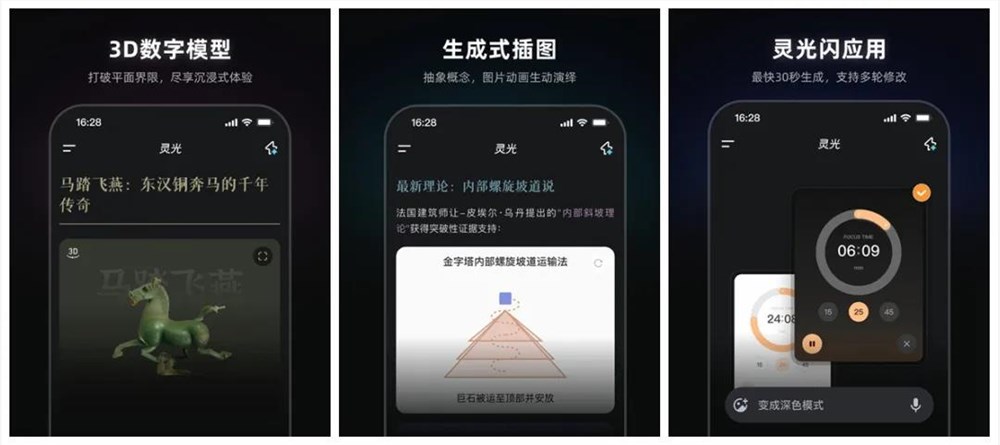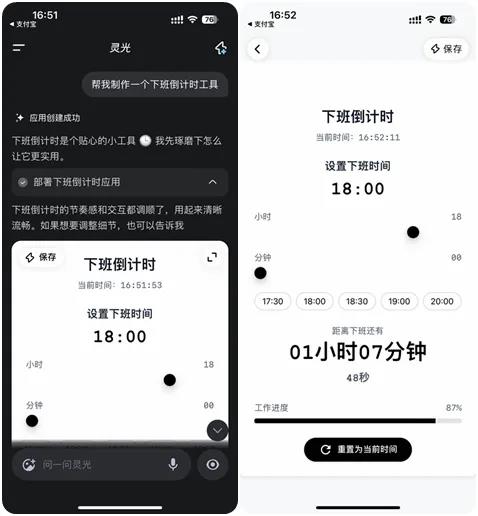In November 2025, the Chinese AI circle is quite lively.
On November 17, Alibaba launched a public test of its personal AI assistant "Qwen," directly competing with ChatGPT. The goal is clear: to seize the AI lifestyle entrance.
Just a day later, Ant Group released a multimodal AI assistant called "Lingguang" and successfully captured market attention with its breakthrough "30-second app generation" capability. Within just two days, the number of downloads of Lingguang exceeded 500,000, and it underwent eight emergency expansions in three days. It climbed to the 6th position on the App Store's overall chart, becoming a rare phenomenon-level new product this year.
But behind the heat, what truly brought Lingguang into the spotlight was its completeness in product logic, technical path, and strategic philosophy.

01
The second half of AI applications: chatting alone is not enough
From 2024 to 2025, the narrative of the AI industry has quietly changed:
The BCG "New Era of AI Work" report shows that China's AI adoption rate is as high as 87%, far exceeding the global average, but user satisfaction is only 62%. The core pain point is straightforward and sharp: most AI remains limited to information Q&A and cannot solve real tasks.
Previously, it was about who had a stronger model or more elegant answers. Now, it's about: what real problems can AI solve? Can users save time because of it?
This shift from "obtaining information" to "solving problems" directly pushes the AI entry competition from a traffic contest to a productivity battle.
Ant Group CTO He Zhengyu said at yesterday's media briefing that the significant change in China's AI this year came from DeepSeek's explosion—it made all large model companies realize that AGI is no longer a distant legend, but a real competition.
Ant then made organizational adjustments at the beginning of the year, establishing an "Inclusive AI" team, integrating research, engineering, and products, with "extreme efficiency" as the core concept of AGI:
Model training emphasizes resource efficiency (jumping directly from hundreds of billions to trillions of models)
Product pursuit of usage efficiency (lowering barriers, improving understandability)
Lingguang's emergence is the first large-scale application of Ant's AGI "efficiency value" in consumer scenarios.
02
Ordinary people can also "make apps"
What makes Lingguang different? In one sentence: allowing ordinary people to create tools without any barriers. This is its core difference from other big tech companies.
Lingguang is the first to achieve 30-second generation of daily small apps on mobile devices. Its core functions are: "Lingguang Dialogue" (structured visual answers), "Lingguang Eyes" (real-time visual interaction), and "Lingguang Flash App" (one-sentence generation of interactive tools).
Lingguang's director Cai Wei emphasized that Lingguang did not evolve from email, but from web pages. Information should not be presented only in text, but like quality web pages, rich in images and texts.

Now, general AI assistants have a common problem: when you ask them something, they often give you a long, dense block of text that's hard to read.
Lingguang's smartest move is to simplify this process. Its "Lingguang Dialogue" feature is very interesting. It doesn't spew long texts, but does a high-intensity screening and structuring of information. If you ask for directions, it directly gives you an interactive map; if you ask about the structure of an object, it might generate a dynamic 3D model for you to view.
This relates to Lingguang's underlying logic — the first multi-modal content generation in code in the industry. It supports full modal outputs such as 3D, audio, charts, animations, maps, etc.
If "Lingguang Dialogue" solves the efficiency of viewing, then "Lingguang Flash App" solves the barrier of doing.
This is Lingguang's biggest breakout: it can generate a customizable, interactive daily small app within 30 seconds on a mobile device.
I tried it out. By inputting a single instruction, "Help me make a countdown tool after work," it really generated the tool within 30 seconds, with a smooth interactive experience and strong practicality.

Figure caption: Lingguang generates a countdown tool for work
Social platforms have been flooded with various cases of users generating apps with Lingguang, such as "making a medicine reminder for parents."
A user's comment was particularly spot-on: "I used to think advanced AI features were too far from ordinary people. Now, I can create a tool by just saying a sentence. Finally, I feel like 'My AI, my creation'."
03
The road of mass developers is too tempting
You may ask, why did Lingguang choose the seemingly niche direction of "generating apps in 30 seconds" when mainstream AI assistants are all competing on "dialogue quality"?
The answer lies in the long tail of demand.
Tencent Yuanbao is tied to WeChat, ByteDance Douba has a monthly active user base of 172 million. Regardless of social or content scenarios, these AIs are essentially still "answering questions", not "solving problems".
Lingguang's innovation lies in giving "problem-solving" power back to users.
Moms want to record their children's growth, office workers want to manage their time, travelers want to plan routes—these fragmented needs cannot be met by general AI. But Lingguang allows users to "create" small apps with just one sentence, taking only 30 seconds to one minute.
C-end users have now shifted from "curiosity and trial" to "solving problems", no longer satisfied with AI that can chat and talk. General dialogue AI struggles to cover personalized, fragmented long-tail needs. Based on its own genes, Ant has formed a unique differentiation competitive path.
In short, Ant Lingguang continues the "inclusive technology" gene, walking the path of "creative AI".
This differentiation hits the core issue of AI competition—the homogenized internal competition. When all AIs are competing on who can chat better, Lingguang opens up a new dimension: from "asking for answers" to "building tools".
According to reports, Lingguang relies on the Ant Bai Ling large model with trillions of parameters, and pioneers full-code generation to realize multi-modal output; through Agentic multi-agent architecture, dynamically dispatch image, 3D, animation tools for real-time collaboration; from the AI medical assistant "AQ" to verify scene closure, to layout embodied intelligence to extend physical space, it has built a complete chain of "technology - application - reality".
04
Where will the entrance war end?
What will be the end of this AI entrance war?
The flow faction's logic is: the entrance is where "users stay" — whoever has higher daily active users and longer usage time wins.
But Lingguang gives a different answer: the entrance should be the first place users think of when they need to solve a problem. From this perspective, the competition for AI entrances is essentially a different understanding of "user value".
Qwen follows the "super entrance" route. Alibaba plans to integrate various life scenarios such as maps, food delivery, ticket booking, office, study, shopping, and health into the Qwen APP. This logic is similar to Gaode's "Street Ranking" and Taobao's "Flash Purchase" — building a traffic hub and then distributing to various service scenarios.
Lingguang follows the "activating long-tail demands" route. When ordinary people become "mass developers", a huge number of unmet fragmented demands will be activated. For example, a mom creates her own child-rearing tool, a student creates his own English vocabulary learning tool, and an elderly person creates his own medication reminder — these seemingly small applications, when aggregated, form a vast demand ecology.

Figure caption: Making an English vocabulary learning tool with Lingguang
The current chaos is just the beginning. The future may trend toward the integration of "professional tools + scenario ecosystems." No matter how it evolves, the core logic of "user-created value" will not change. Lingguang's emergence not only changes the habit of users "passively using AI," but also opens up a brand new imagination space for AI applications.
05
Conclusion
While ChatGPT focuses on dialogue optimization and Gemini3.0 accelerates toolization, Lingguang provides a uniquely Chinese answer:
AI is not only smarter, but also more practical; it's not only about understanding what you say, but also helping you do it; it's not only serving you, but also letting you have creativity.








